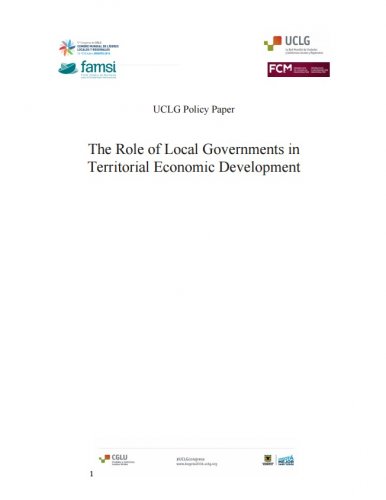The economic challenges of the 21st century are daunting. Rapid urbanization resulting from large-scale displacements of populations, with attendant crises of mass poverty and unemployment, threaten to persist well into this century, especially in the Global South, driven by changing production systems in the countryside, soil depletion, water shortages, climate change, and population growth itself. There are looming dangers arising from current economic turmoil and consequent social inequality; these include homelessness, food insecurity, and widespread recourse to informal livelihoods and crime.
In the struggle to tackle these issues, to mitigate their worst effects and to move towards a world in which people may live the life they choose, the public institutions on the front lines are local and regional governments (LRGs).
Download The Role of Local Governments in Territorial Economic Development
This paper examines the crucial role of LRGs in economic development. It addresses national and supranational governments, international development partners, as well as LRGs themselves and their local government associations (LGAs). Its purpose is to identify the policy directions urgently needed by each of these actors to enable LRGs to perform this role effectively for their citizens. It parts from the premise that LRGs are political actors and they can and should influence the definition of policies, and not only in its implementation through small actions.
Table of Contents
UCLG Policy Paper
The Role of Local Governments in Territorial Economic Development
1. Introduction
1.1 Purpose and context
1.2 Why local governments matter to economic development
1.3. Characteristics of local economic development (LED)
2. LED Enabling Policies
2.1 Decentralizing responsibility, authority, and capacity
2.2 Creating an enabling environment for LED
2.3 Building an alliance of partners
2.4 Establishing structures of governance and management
2.5 Encouraging entrepreneurship and attracting investment
2.6 Nurturing innovation
2.7 Promoting the green economy
2.8 Mitigating poverty, inequality, and social exclusion
2.9 Fostering local culture
2.10 The social economy, solidarity economy and the third sector. Another economy is possible.
2.11 LED and the Gender Focus
2.12 Evaluation as a LED’s tool
3. Challenges
3.1 Building capacity
3.2 Responding to the challenges
4. Conclusion and recommendations
Bibliography
Format
Source





